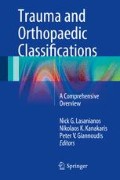Abstract
In 1990 Patte [1] reported the following classification system for Rotator Cuff Tears, which described full thickness tears in two dimensions. The proposed method of classification is based on the:
Access this chapter
Tax calculation will be finalised at checkout
Purchases are for personal use only
References
Patte D. Classification of rotator cuff lesions. Clin Orthop Relat Res. 1990;254:81–6.
Patte D. Periarthritis of the shoulder. The sub-acromio-coracoid space. Rev Chir Orthop Reparatrice Appar Mot. 1988;74(4):274–7.
Patte D, Debeyre J. Surgical treatment of ruptures of the rotator cuff of the shoulder. Chirurgie. 1983;109(4):337–41.
Patte D, Goutallier D. Periarthritis of the shoulder. Calcifications. Rev Chir Orthop Reparatrice Appar Mot. 1988;74(4):277–8.
Morse K, Davis AD, Afra R, Kaye EK, Schepsis A, Voloshin I. Arthroscopic versus mini-open rotator cuff repair: a comprehensive review and meta-analysis. Am J Sports Med. 2008;36(9):1824–8.
Huisstede BM, Koes BW, Gebremariam L, Keijsers E, Verhaar JA. Current evidence for effectiveness of interventions to treat rotator cuff tears. Man Ther. 2011;16(3):217–30.
Seida JC, LeBlanc C, Schouten JR, Mousavi SS, Hartling L, Vandermeer B, Tjosvold L, Sheps DM. Systematic review: nonoperative and operative treatments for rotator cuff tears. Ann Intern Med. 2010;153(4):246–55.
Duquin TR, Buyea C, Bisson LJ. Which method of rotator cuff repair leads to the highest rate of structural healing? A systematic review. Am J Sports Med. 2010;38(4):835–41.
Coghlan JA, Buchbinder R, Green S, Johnston RV, Bell SN. Surgery for rotator cuff disease. Cochrane Database Syst Rev. 2008;(1):CD005619.
Author information
Authors and Affiliations
Corresponding author
Editor information
Editors and Affiliations
Rights and permissions
Copyright information
© 2015 Springer-Verlag London
About this chapter
Cite this chapter
Lasanianos, N.G., Panteli, M. (2015). Rotator Cuff Tears. In: Lasanianos, N., Kanakaris, N., Giannoudis, P. (eds) Trauma and Orthopaedic Classifications. Springer, London. https://doi.org/10.1007/978-1-4471-6572-9_7
Download citation
DOI: https://doi.org/10.1007/978-1-4471-6572-9_7
Published:
Publisher Name: Springer, London
Print ISBN: 978-1-4471-6571-2
Online ISBN: 978-1-4471-6572-9
eBook Packages: MedicineMedicine (R0)

